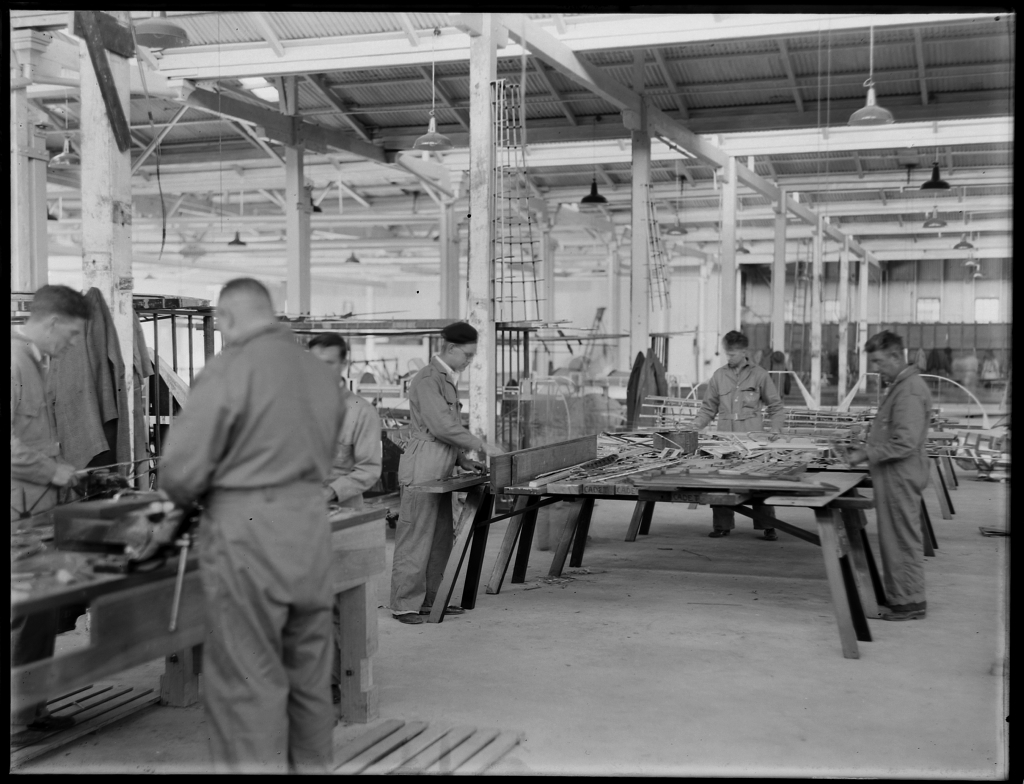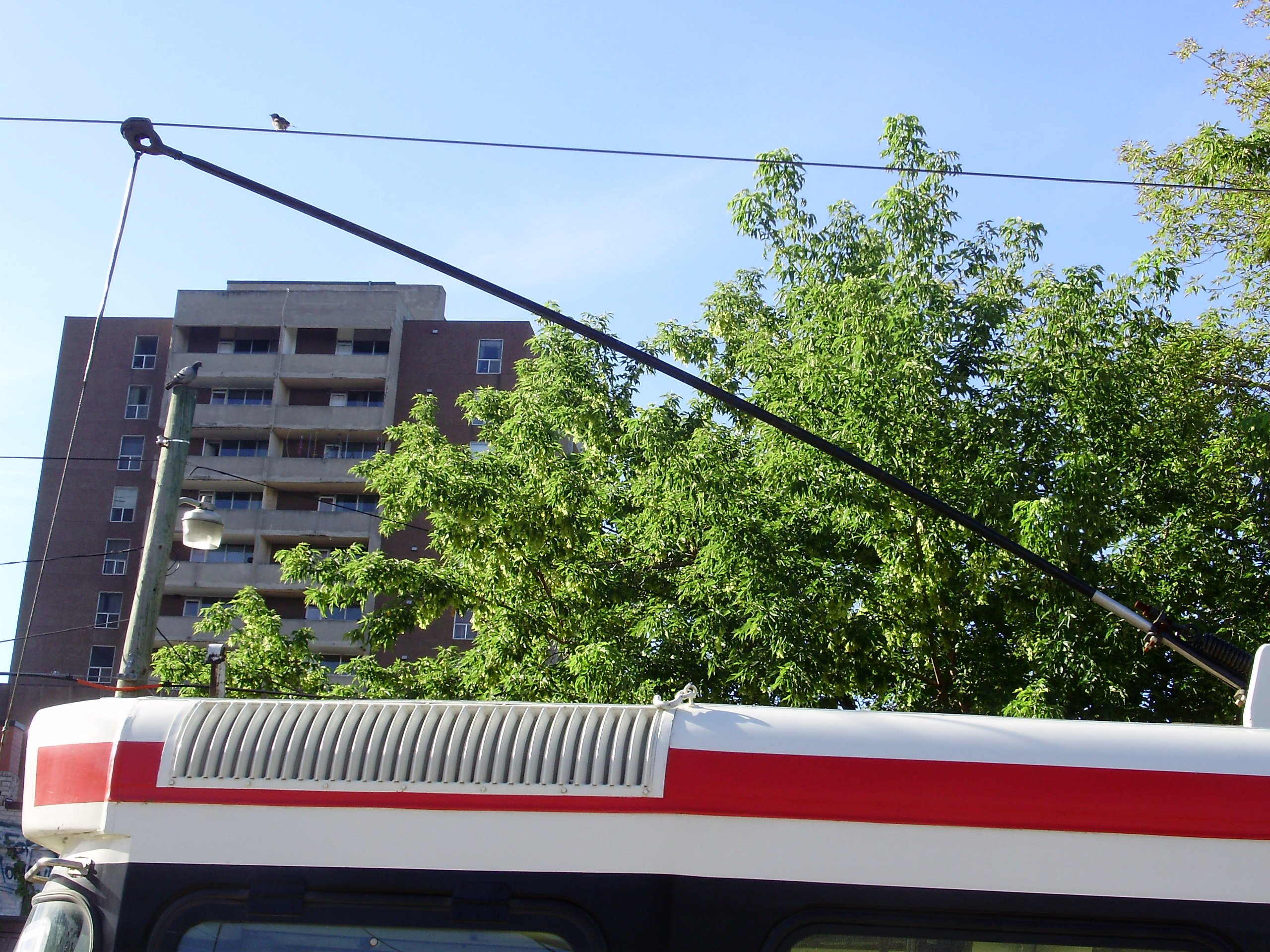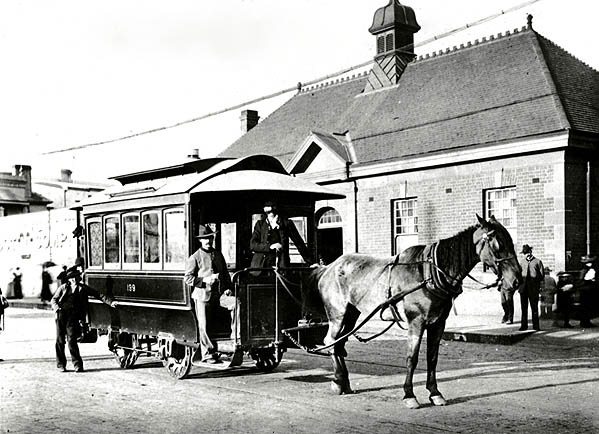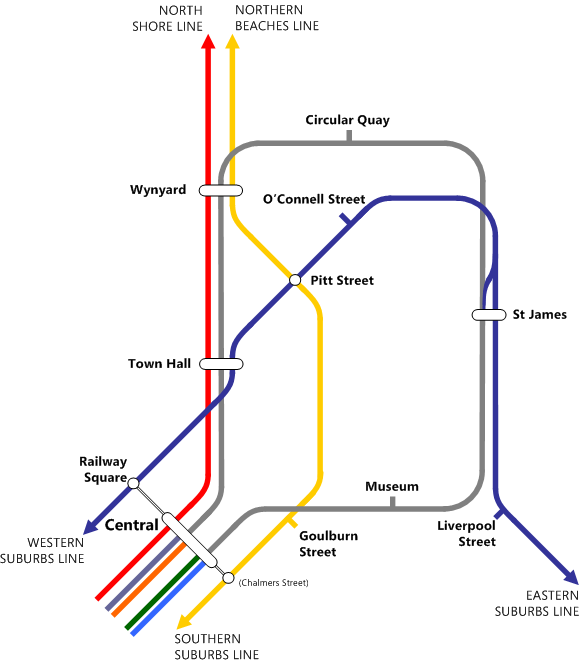|
D-class Sydney Tram
The D-class trams were a class of single bogie Californian Combination type trams operated on the Sydney tram network with open cross benches at the ends and a saloon in the centre. Seating capacity was originally 32, later being increased to 34. 134s (D102), 136s (D106), 112s (D117), 137s (D119) and 43s (D)123 always operated from Randwick Workshops. 131s (ex D99) saw service at Newcastle, along with 135s (ex D103) which later saw service at North Sydney. 132s (ex D105) and 133s (ex D116) saw service at both Enfield and North Sydney. 43s was scrapped at Randwick, 112s was sold to a private buyer; 137s went to Brisbane as number 16 in their works roster, and 134s went to the Sydney Tramway Museum. Preservation Two have been preserved: *102 at the Sydney Tramway Museum, converted to track scrubber in 1930 and renumbered 134s, operational and was used as a track scrubber on: **the Eastern Suburbs railway line between: ***13 October 1978 and 22 November 1978 page 22 page 15 *** ... [...More Info...] [...Related Items...] OR: [Wikipedia] [Google] [Baidu] |
The Spit, New South Wales
The Spit is an urban locality in the suburb of Mosman in Sydney, New South Wales, Australia. The Spit is located in the local government area of the Municipality of Mosman and is part of the Lower North Shore. Landmarks The Spit protrudes off Beauty Point and is home to the Spit Bridge, a bascule bridge opened in 1958 over Middle Harbour. The bridge opens at set times to allow yachts with high masts to pass. The Spit is the site of the Middle Harbour Yacht Club and a marina. History The Aboriginal name for The Spit is ''Burra Bra''. From as early as 1834, a ferry operated by Barney Kearns carried passengers across the waters of Middle Harbour. From the 1850s, a punt operated by Peter Ellery, carried passengers across for sixpence and horse-drawn vehicles were charged 1s 6d. If the horses swam across, there was a reduction of sixpence. In 1889, it was replaced by a government steam punt. A wooden bridge was opened in 1924 after the electric tram A tram (also ... [...More Info...] [...Related Items...] OR: [Wikipedia] [Google] [Baidu] |
Clyde Engineering
Clyde Engineering was an Australian manufacturer of locomotives, rolling stock, and other industrial products. It was founded in September 1898 by a syndicate of Sydney businessmen buying the Granville factory of timber merchants Hudson Brothers. The company won contracts for railway rolling stock, a sewerage system, trams and agricultural machinery. In 1907 it won its first contract for steam locomotives for the New South Wales Government Railways. By 1923 it had 2,200 employees. After contracting during the depression it became a major supplier of munitions during World War II. In 1950 it was awarded the first of many contracts for diesel locomotives by the Commonwealth Railways after it was appointed the Australian licensee for Electro-Motive Diesel products. Apart from building locomotives and rolling stock, Clyde Engineering diversified into telephone and industrial electronic equipment, machine tools, domestic aluminium ware, road making and earth making equipmen ... [...More Info...] [...Related Items...] OR: [Wikipedia] [Google] [Baidu] |
Ritchie Brothers
Ritchie Brothers was an Australian railway rolling stock and tram manufacturer based in the Sydney suburb of Auburn. History In 1857, Robert Ritchie took over the blacksmith business of Joseph Whiting of Parramatta. In 1876, Ritchie was awarded a contract by the Government of New South Wales for 150 wagons. In 1882, the business relocated to Marion Street, Auburn. Ritchie Brothers built carriages for the New South Wales Government Railways including American suburban carriages, Bradfield suburban, Silver City Comet, 500 class trailers and 72 foot carriages. It also built D and N class trams for the Sydney tram network. It closed in the 1950s with the plant and equipment sold to Australian Electrical Industries.Plant of Old Established Car Builder Sold ''Railway Transportation ''Railway Transportation'' was a Sydney-based monthly trade magazine covering rail transport in Australia. It was regularly used for promotion and advertising by railway organisations and ... [...More Info...] [...Related Items...] OR: [Wikipedia] [Google] [Baidu] |
Trolley Pole
A trolley pole is a tapered cylindrical pole of wood or metal, used to transfer electricity from a "live" (electrified) overhead line, overhead wire to the control and the electric traction motors of a tram or trolley bus. It is a type of current collector. The use of overhead wire in a system of current collection is reputed to be the 1880 invention of Frank J. Sprague, but the first working trolley pole was developed and demonstrated by Charles Joseph Van Depoele, Charles Van Depoele, in autumn 1885.William D. Middleton, Middleton, William D. (1967). ''The Time of the Trolley'', pp. 63–65, 67. Milwaukee: Kalmbach Publishing. . History An early development of an experimental tramway in Toronto, Ontario, was built in 1883, having been developed by John Joseph Wright (inventor), John Joseph Wright, brother of swindler Whitaker Wright. While Wright may have assisted in the installation of electric railways at the Canadian National Exhibition (CNE), and may even have used a pol ... [...More Info...] [...Related Items...] OR: [Wikipedia] [Google] [Baidu] |
Volt
The volt (symbol: V) is the unit of electric potential, Voltage#Galvani potential vs. electrochemical potential, electric potential difference (voltage), and electromotive force in the International System of Units, International System of Units (SI). Definition One volt is defined as the electric potential between two points of a electrical conductor, conducting wire when an electric current of one ampere dissipates one watt of power (physics), power between those points. It can be expressed in terms of SI base units (metre, m, kilogram, kg, second, s, and ampere, A) as : \text = \frac = \frac = \frac = \text\text^2\text^. Equivalently, it is the potential difference between two points that will impart one joule of energy per coulomb of charge that passes through it. It can be expressed in terms of SI base units (metre, m, kilogram, kg, second, s, and ampere, A) as : \text = \frac = \frac = \frac = \text\text^2\text^. It can also be expressed as amperes times ohms (curre ... [...More Info...] [...Related Items...] OR: [Wikipedia] [Google] [Baidu] |
Direct Current
Direct current (DC) is one-directional electric current, flow of electric charge. An electrochemical cell is a prime example of DC power. Direct current may flow through a conductor (material), conductor such as a wire, but can also flow through semiconductors, electrical insulation, insulators, or even through a vacuum as in electron beam, electron or ion beams. The electric current flows in a constant direction, distinguishing it from alternating current (AC). A archaism, term formerly used for this type of current was galvanic current. The abbreviations ''AC'' and ''DC'' are often used to mean simply ''alternating'' and ''direct'', as when they modify ''Electric current, current'' or ''voltage''. Direct current may be converted from an alternating current supply by use of a rectifier, which contains Electronics, electronic elements (usually) or electromechanical elements (historically) that allow current to flow only in one direction. Direct current may be converted into alt ... [...More Info...] [...Related Items...] OR: [Wikipedia] [Google] [Baidu] |
Overhead Line
An overhead line or overhead wire is an electrical cable that is used to transmit electrical energy to electric locomotives, Electric multiple unit, electric multiple units, trolleybuses or trams. The generic term used by the International Union of Railways for the technology is ''overhead line''. It is known variously as overhead catenary, overhead contact line (OCL), overhead contact system (OCS), overhead equipment (OHE), overhead line equipment (OLE or OHLE), overhead lines (OHL), overhead wiring (OHW), traction wire, and trolley wire. An overhead line consists of one or more wires (or Overhead conductor rail, rails, particularly in tunnels) situated over rail tracks, raised to a high electrical potential by connection to feeder stations at regularly spaced intervals along the track. The feeder stations are usually fed from a High voltage, high-voltage Electricity distribution, electrical grid. Overview Electric trains that collect their current from overhead lines use a de ... [...More Info...] [...Related Items...] OR: [Wikipedia] [Google] [Baidu] |
Trams In Sydney
The Sydney tramway network served the inner suburbs of Sydney, Australia, from 1879 until 1961. In its heyday, it was the largest in Australia, the second largest in the Commonwealth of Nations (after Trams in London, London), and one of the largest in the world. The network was heavily worked, with about 1,600 cars in service at any one time at its peak during the 1930s (in comparison, there are about 500 trams in Melbourne today). Patronage peaked in 1945 at 405 million passenger journeys. Its maximum street trackage totalled 291 km (181 miles) in 1923. History Early tramways Sydney's first tram was horse-drawn, running from the Redfern railway station, old Sydney railway station to Circular Quay along Pitt Street.''The 1861 Pitt Street Tramway and the Contemporary Horse Drawn Railway Proposals'' Wylie, R.F. Australian Railway History, Australian Railway Historical Society Bulletin, February, 1965 pp21-32 Built in 1861, the design was compromised by the desire to h ... [...More Info...] [...Related Items...] OR: [Wikipedia] [Google] [Baidu] |
Sydney Tramway Museum
The Sydney Tramway Museum, operated by the South Pacific Electric Railway Co-operative Society, is Australia's oldest tramway museum and the largest in the southern hemisphere. It is located at Loftus in the southern suburbs of Sydney. History Construction of the museum at its original site on the edge of the Royal National Park commenced in August 1956. It was officially opened in March 1965 by NSW Deputy Premier Pat Hills. The facilities were basic, initially a four-track shed built with second hand materials and approximately 800 metres of running track. In 1975, the Government of New South Wales approved the museum moving to a new site across the Princes Highway adjacent to Loftus railway station. Construction commenced in April 1980, with the first trams transferred from the old site in November 1982. It officially opened on 19 March 1988. The former Railway Square tramway shelter that had been disassembled in 1973 was reassembled. The last tram left the Royal National ... [...More Info...] [...Related Items...] OR: [Wikipedia] [Google] [Baidu] |
Eastern Suburbs Railway Line
The Eastern Suburbs Railway (ESR) is a commuter railway line in Sydney constructed in the 1970s. It is operated by Sydney Trains and has stations at Martin Place, Kings Cross, Edgecliff and Bondi Junction. In addition, it has dedicated platforms at Town Hall, Central and Redfern stations. All of these stations are underground. The Eastern Suburbs railway connects with the Illawarra line at Erskineville, forming the Eastern Suburbs & Illawarra Line. The line features turnbacks at Central, Martin Place and Bondi Junction. There was also previously a rarely used cross-over at Edgecliff. It operates a service every 3 to 5 minutes during weekday peak hours and 8 to 10 minutes at all other times. Design The twin-track Eastern Suburbs line consists of eight stations connected mainly by viaduct and tunnel. The stations are finished in terrazzo and colourful tiles. Alignment From a tunnel portal north of Erskineville, the Eastern Suburbs line runs north to Redfern, then ... [...More Info...] [...Related Items...] OR: [Wikipedia] [Google] [Baidu] |
Cronulla Railway Line
The Cronulla railway line is a suburban branch line serving the southern suburbs of Sydney, New South Wales, Australia. Sydney Trains operates electric passenger train services over the line as part of its Eastern Suburbs & Illawarra Line. Description of route The line branches off the Illawarra railway line immediately south of Sutherland station, with a sharp turn towards the east. Due to sharpness of this curve, trains are limited to and noise walls have been built on both sides of the line to reduce noise levels for local residents. It is double track throughout, with all stations having island platforms, except Cronulla. Cronulla station has a long platform (which is numbered as two platforms) capable of holding two eight-car trains, and three stabling sidings. The entire line is controlled from Sydenham Signalling Centre and is equipped with standard NSW double colour light signals. The line is not designed for freight trains, so operation of freight trains is normally ... [...More Info...] [...Related Items...] OR: [Wikipedia] [Google] [Baidu] |
Inner West Light Rail
The Inner West Light Rail is a light rail line in Sydney, New South Wales, Australia, running from Central railway station, Sydney, Central railway station through the Inner West to Dulwich Hill railway station, Dulwich Hill and serving 23 stops. It was the original line of the Light rail in Sydney, Sydney light rail network. Services on the line are branded as the L1 Dulwich Hill Line since 2014. Most of the Inner West Light Rail is built on the path of a former goods railway line. The first section of light rail opened on 11 August 1997, and the line was extended in 2000 and 2014 along the former goods corridor. Operation and maintenance of the line is contracted to the ALTRAC Light Rail consortium by the New South Wales Government's transport authority, Transport for NSW. Services are operated by Transdev Sydney as a member of ALTRAC Light Rail. Background Most of the alignment of the Dulwich Hill Line had its origins as the Rozelle–Darling Harbour railway line, Rozelleâ ... [...More Info...] [...Related Items...] OR: [Wikipedia] [Google] [Baidu] |








